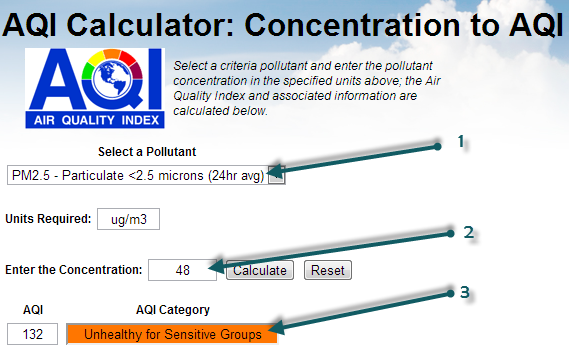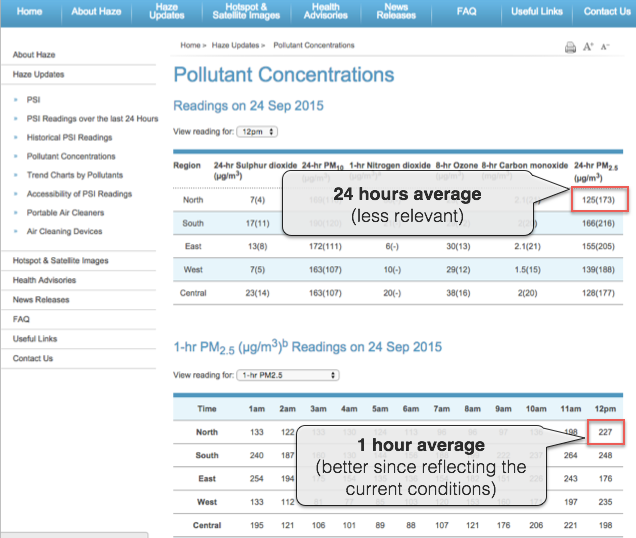In April 2014, the Singapore NEA has updated the PSI calculation to also include PM2.5. http://www.nea.gov.sg/anti-pollution-radiation-protection/air-pollution-control/psi
With the recent Southeast Asia Smog from Indonesia affecting Singapore and now Malaysia, we got many questions about why there is a difference between the data which can be read from Singapore NEA website (nea.gov.sg) and the World Air Quality Index project Singapore webpage.
Örneğin bugün NEA web sitesinde okunabilecekler:

Bazı tarihsel nedenlerden dolayı Singapur, Hava Kalitesini değerlendirmek için PSI'yı ( Kirletici Standart Endeksi ) kullanıyor. Yukarıdaki görselde 1 rakamı PSI değerlendirmesi için kullanılan PM10 değerine karşılık gelmektedir. 67(/59) değeri, 59 PSI'ya karşılık gelen 67 μg/m3 olarak okunabilir. PSI, kirleticilerin her biri için bireysel PSI'nın maksimumu olarak değerlendirilir: PM10 , SO2 , NO2 , O 3 (Ozon) ve CO 2 .
PSI(Singapore-North) = max( PSIPM10-based, ... PSIO3-based )= max (59, ..., 77) = 77
Bununla birlikte ilginç olan şey, aynı tabloda PM2.5 verilerinin de son sütunda sunulmasıdır (bkz. 3). Bu veriler yalnızca μg/m3 cinsinden sağlanır (bkz. 2) ve PSI gibi bir şeye dönüşüm yoktur (yani PM2,5 kütlesinden Kirlilik veya Kalite İndeksine dönüşüm). Ancak bu dönüşüm mevcuttur ve ABD Çevre Koruma Ajansı tarafından tanımlanmaktadır. Dönüşümü yapmanın en kolay yolu airnow.gov adresinde bulunan çevrimiçi hesap makinesini kullanmaktır:

If you select the PM2.5 (1), then enter the mass concentration of 48 (2), can click on Calculate, you will obtain the AQI of 132 (3). So, based on the PM2.5 AQI conversion, the PSI that is used for Singapore could be extended (let's call it PSI++) to also take into account the PM2.5 information. In which case, the PSI++ would be the maximum of the regular PSI (based on PM10 only) and the PM2.5 AQI:
PSI++ = max( PSI, AQIPM.25 ) = max( 77, 132 ) = 132
This PSI++, that is commonly referred as AQI (or Air Quality Index), is what is being used on the the World Air Quality Index project, for all the cities (provided PM2.5 is available for the city). And this explains why the values are different between the NEA website and the World Air Quality Index project.
Moreover, when doing the convertion, make sure you use the 1-hour reading for the PM2.5 concentration rather than the 24-hours averaged value, as shown on the below image:

http://www.haze.gov.sg/haze-updates/pollutant-concentrations/type/PM25-1Hr
If you want to know more about PM10 vs PM2.5, and especially why PM10 is still used, please check the faq entry about why is PM2.5 often higher than PM10? Is PM10 still a relevant measure?
--
For more information about specific countries or continent, please refer to those articles: Thailand and Malysia - India - China - Hong Kong / Canada (Air Quality Health Index) - South America - Australia - Quebec and Montreal - Singapore - Poland - Indonesia .
For information about the 24 hours averaging used or Ozone and Particulate Matter (PM2.5), please refer to those two articles: Ground Ozone Index - PM2.5 Instant Cast
